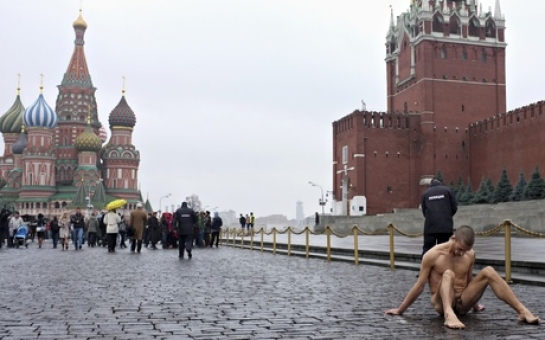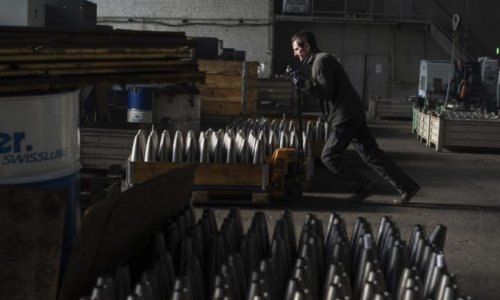A video taken using a handheld camera and posted online moments later shows tourists gawping as he sits on the ground. A police car arrives, and an officer orders the man to get up. But the man cannot get up – because he is attached to the icy cobbles with a single, long nail that is driven through his scrotum and into the stones below.This was only the third piece of protest art in the oeuvre of St Petersburg native Petr Pavlensky, but he has already made a name for himself as one of the most intriguing figures on the contemporary Russian art scene. Tapping into the instincts that drove Pussy Riot, and their progenitors, the Voina art collective, Pavlensky fuses risque performance with a deep disdain for the current political environment in Russia. Having previously wrapped himself naked in a coil of barbed wire, and sewn his lips together, this third wince-inducing stunt attracted international attention.In a statement released to coincide with the performance, Pavlensky said his action, titled Fixation and timed to coincide with Russia's annual Police Day, was "a metaphor for the apathy, political indifference and fatalism of modern Russian society". Pavlensky had a blanket thrown over him by the confused police officers and was eventually detached from the stones and taken to hospital. He was discharged that evening, and released by the police without charge – only for them to open a case of "hooliganism motivated by hatred of a particular social, ethnic or religious group" a few days later. It is the same article of the law that was used against Pussy Riot and can carry a jail sentence of several years.A fortnight later, Pavlensky is at the railway station in St Petersburg, about to take the night train back to the capital, where he has been summoned by police for questioning the next day. There are rumours in the media that he may be arrested. We meet just before midnight, before he boards his train, and it is hard not to notice the rather forlorn canvas rucksack slung over his shoulder. He appears to have surprisingly few possessions with him for someone who could end up spending months behind bars."What do you mean?" he says, matter-of-factly. "I've got socks, pants, everything. I'm ready for anything."He sounds relaxed and confident, although there is a nervous intensity in his eyes. Escaping the long arm of Russian justice by going on the run was never an option for Pavlensky. "I think that would have discredited everything I'd done before, if at the first sign of danger I'd gone into hiding. So I decided to take a position of strength, because there is nothing to be afraid of. You can be afraid if you feel you are guilty of something and I don't. Anything the authorities do against me means discrediting themselves. The more they do with me, the worse they make it for themselves."He says the same impulse informs his art: "Whenever I do a performance like this, I never leave the place. It's important for me that I stay there. The authorities are in a dead-end situation and don't know what to do. They can't ask the person to leave a square, because he's nailed to the square. And they can't do anything with a man inside barbed wire."The influential gallery owner and critic Marat Guelman called Pavlensky's act "the artistic equivalent of setting yourself on fire" and said it was a gesture of hopelessness and desperation. "It was a message to society," he told a Russian arts journal. "We all more or less share his position. People have been forced into a corner – the choice is between leaving, going to prison, or joining up with those in power."But, in Pavlensky's mind, his action was less a helpless cry of anguish than an aggressive statement of defiance. His performances are not only a protest against the system, but also a protest against people's apathy. "When I did the Carcass piece with the barbed wire, I was not just saying how wonderful our legal system is – people are inside this wire, which torments them, stops them from moving, and they feel pain from every movement. I was also saying people themselves are this barbed wire and create the wire for themselves."Pavlensky was born in St Petersburg and studied at art college, which he describes as a "disciplinary institution that aims to make servants out of artists". He left in 2012, without completing the course. He says he has a broad range of artistic influences. "I am very interested in Caravaggio, even though he worked with canvas and oils. He had a very serious life project, though: he made works with the theme of self-harm, where he translates real events on to the bodies of his subjects. He isn't a decorative artist. I am very critical of any decorative art as an idea, the idea of ornamentalism and concealment. Everything that does the opposite, that brings things out and reveals how things actually are, this is what interests me."Pavlensky takes inspiration from a long line of Russian protests, particularly the "Moscow activism" school of the 1990s, and most recently the protest group Voina, who were noted for their outrageous activist art. Voina's performances included staging a mass orgy inside Moscow's biological museum the day before the election of Dmitry Medvedev as president in 2008, under a banner that read: "Fuck for the teddy bear heir."Later, they painted a giant penis on a St Petersburg bridge, just before it was raised at night for ships to pass, causing the penis to "erect" and point at the FSB security services building on the embankment. The group won a major art prize for the stunt (the Innovatzia, the equivalent of the Turner prize), though they were also pursued by Russian authorities on criminal charges.Two of the original Voina artists went on to form the punk collective Pussy Riot, who with their mix of music, art and activism also chose Red Square for one of the first performances, in 2011. Later, they would stage their fateful action in the Cathedral of Christ the Saviour, which would see three of them stand trial for "hooliganism motivated by religious hatred".Pavlensky says it was during the Pussy Riot trial that he first began to understand the need for a more radical approach to art. "Their trial affected me more than many things in my own life. I started looking at other people and wondering why they were not doing anything. And that is when I had the important realisation that you should not wait for things from other people. You need to do things yourself."The idea for his most recent performance came when he was briefly held in a cell after the Carcass stunt. A fellow prisoner regaled him with stories of the Gulag, where prisoners had sometimes nailed their scrotums to trees in an act of protest at the inhumane conditions and miserable existence. "I didn't think much of it at first but then, when I began thinking that the whole country is becoming a prison system, that Russia is turning into a big prison and a police state, it seemed perfect."Some suggested that the act may not have been as gruesome as it seemed, with a piercing having been made prior to the event and the nail simply pushed through, but as we walk along the freezing platform for him to board the Moscow train, Pavlensky insists that he actually drove the nail through that afternoon. "I have the medical report to prove it," he says. "I was careful not to rupture a vein but it was very bloody and sore. They wanted to give me antibiotics and other medications, but I refused."In the end, Pavlensky was not arrested at his questioning the following day in Moscow, but the charges against him still stand, and he remains under investigation. In late January, officers arrived at the cable channel TV Rain and demanded to be given a recording of an interview Pavlensky had given them, saying they needed to examine it as part of a "psychological-linguistic expert analysis" that was being carried out as part of the case against him.Despite the real threat of a jail term, Pavlensky does not plan to stop, and says his unusually painful brand of art comes from an imperative impulse towards radicalism: "It was a very important step for me – to understand what happens when a person becomes an artist, when a person becomes stronger than their indifference and overcomes their inertia. I don't think an artist can exist without this and just be isolated and contemplative. An artist has no right not to take a stand."(theguardian.com)ANN.Az
Petr Pavlensky: why I nailed my scrotum to Red Square
World
21:00 | 06.02.2014

Petr Pavlensky: why I nailed my scrotum to Red Square
On a snowless but chilly afternoon early in the Moscow winter, a 29-year-old man with a gaunt, emaciated face stepped on to the vast expanse of Red Square. He made his way to a spot on the cobblestones not far from the marble mausoleum housing the waxy corpse of Vladimir Lenin, and began to undress. In less than a minute, he was naked.
Follow us !










